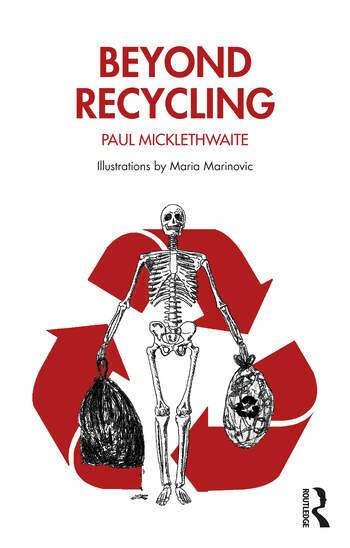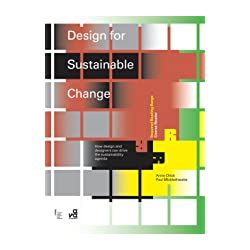Upcycling-as-reuse

Beyond Recycling by Paul Micklethwaite
Illustrations by Maria Fernandez Marinovic
Introduction 1
1 Language 6
2 Things 40
3 Symbols 69
4 Sustainability 89
5 Futures 115
Chapter 1 Language p6
UPCYCLING AND DOWNCYCLING
The term ‘upcycling’ is more widely used… to describe individual repurposing and creative reuse of unwanted objects. p12
Upcyclers seek to preserve every element of the value of an original object. Material and product form are both considered to have value. Recycling typically destroys and then remakes both, often to a lower value (downcycling). Upcycling- as- reuse avoids destroying any part of an object. The act of reprocessing a material, and in so doing destroying its shape in order to remake it as something new, is considered inferior to the preservation of that original shape in a newly made product. Better to stitch together used multi- layer juice cartons to make a shopping bag than melt them down to feed into a new production process to make more juice cartons. The value of the original product can be seen in terms of both the properties of its constituent materials, and its constructed form. Upcycling- as- reuse seeks to preserve both through simple manipulation of the original product such as stitching together, rather than an industrial process involving the fundamental transformation of its materials and their reconfiguration into the same or quite different products. This mode of upcycling is low- tech and accessible to anyone with basic tools and the willingness and aptitude to use them. p13

Upcycling-as-reuse: shopping bag made from juice cartons
This kind of creative reuse has entered the cultural mainstream as an aspirational pursuit for the modern homemaker, aligned to newly fashionable notions of thriftiness and craft. Upcycling is now commonly used to describe attempts at domestic improvement through the regaining or acquisition of handcraft skills and their application to salvaged or neglected products.
This mode of upcycling can be heavily invested with ideology. The drive to create with waste is celebrated for its authenticity. It valorises remaking both for its ends (reducing the disposal of waste), and also its means (fulfilment for the maker). Online communities share their creations, to mutual acclaim. To the experienced eye, upcycled product archetypes constantly reappear, for example lightshades which are an array of plastic bottles, and ashtrays made from flattened melted beer bottles. Whilst the outcomes can be repetitive and derivative, the purposes and processes, both mental and physical, of upcycling are more interesting. It is the process of doing-it-for- yourself in response to your own needs and constraints that is of most value. Online community groups prioritise original upcycling projects over how- to- do- it guidance on emulating existing products. The presumption is that imitating someone else’s response to their own needs will be less satisfying, and less worthwhile, than developing your own. Better to learn from the motivations and processes of someone else, rather than simply mimic their outcome. p14
2 Things 40
ONE- OFFS
Via dedicated books, websites and television shows, we are encouraged to participate in the ‘art of recycling’ by making our own decorative and functional objects from everyday detritus such as plastic bottles, bottle caps and unwanted clothing. Low- cost making was traditionally popularised by children’s television, but is now aimed at adults as ‘upcycling’, in which thrift and craftiness are presented as aspirations for the modern homemaker. Individual upcycling efforts are part of a broader trend of the return of the amateur, and a wider collective rediscovery of making, from knitting to the basic electronics of Raspberry Pi. Amateur making may give us imperfect versions of widely available and quite affordable manufactured products.
It often costs more to make- it- yourself, in both time and money. But the real value lies in the process of making itself. Affluent societies which have become deskilled in a generation now rediscover the pleasures and rewards of doing- it- yourself, rather than simply buying off- the- shelf. p41

Wine glasses made from beer bottles
This collective turn towards making is clearly ideological, a response to the commodification and brandedness of so many elements of life in a developed economy. Craft- based artists and designers have embraced the recycling and reuse agenda, finding new and unforeseen applications for products that are unwanted at the end of their useful lives. These makers often invest their work with an explicit ideological commitment to raising awareness of our collective production of waste. They choose to use recycled materials over readily available non- recycled alternatives. They may also seek to revalorise low- status materials such as plastic bottles by incorporating them into products with a higher status than their original form. The most successful examples have the power to surprise us because they do not look much like discarded waste. They are made well, from materials still in their best condition. The least successful examples of crafty reuse, however, look just like waste materials re- presented in another form. Lacking utilitarian function, it may then be called art, particularly so if made by or for children. The rhetoric can be grandiose: ‘We Create Art to Save the Sea!! … We turn plastic pollution from the ocean into aesthetically powerful art – and bring dramatic attention to the problem.’ Whilst a shark made from recovered marine plastic does not in itself significantly alleviate the problem of waste in the oceans, it is held to have broader symbolic value: ‘These unique art pieces are part of a traveling exhibition that includes educational signage and programs that encourage reducing, refusing, reusing, repurposing and recycling’ (Artula Institute for Arts and Environmental Education, 2020). Here art meets ideology. p42
Many creative practitioners are called both artist and designer, depending on who views, or reviews, their work. It can pay dividends to be seen as both, to appeal to a broad audience. Whichever label is used, all these products of art and/ or design are essentially handmade, in contrast to the mechanical mass- produced origins of many of the objects that they repurpose. This has consequences. The resulting products are invariably relatively expensive due to the high investment of labour, skilled or unskilled. Such efforts can also never offer a proportionate response to the scale of waste production. Our waste streams are generated by immense industrial manufacturing and distribution systems. Handmade responses, even when considered collectively, are unable to accommodate the huge volumes of waste generated. Upcycled designs of this kind therefore act as token gestures. Their value in responding to ever- increasing material waste streams is symbolic. At best they are examples of creative virtuosity motivated by the failings of the producers and consumers of the first- generation product. These are also mostly products of reuse, rather than recycling, if no reprocessing of materials has taken place in the making of the new object. The value of these practices does not therefore lie in a quantifiable contribution to addressing waste generation and disposal. Such practices, and their products, are propositional – they enable us to question the system of industrial production that they critique. Yet they also inescapably reside within that system, perhaps themselves participating as commercially available products. The online marketplace etsy.com has helped to dissolve any distinction between amateur and professional makers; homemade no longer means not-for-profit. Selling online allows makers of all types and levels to make money from their craft. Recycled products abound on etsy.com. Whilst this combination of factors can make us feel better, it represents a largely symbolic engagement with the deeper structural challenges of how we otherwise make things. The extent to which one- off products of reuse can have a meaningful impact, even if replicated, is likely to be limited. p46
4 Sustainability 89
THE LIMITS OF REUSE
To confuse things, what has traditionally been considered as reuse – the repurposing or minimal adaptation of a product – is often now called ‘upcycling’, as discussed in Chapter 1. Too often upcycling is an essentially reactive and improvised practice which seeks ways to retain the value of waste materials through new and self- consciously creative configurations of unwanted materials. This is a familiar mode of self- styled ‘sustainable’ design.
Waste is, after all, a design flaw, and designing- out the production of waste in the first place (i.e. ‘reduce’) is the best response. Uncritical celebration of upcycling may actually do harm if it distracts us from more meaningful ways of addressing material waste. Upcycling, as a mode of reuse, does not address the systemic causes of waste production, only its most visible effects. p99
Many recycled products simply postpone the point at which their materials are disposed of in the conventional way – landfill – rather than contributing to the perpetuating material cycles advocated by Cradle- to- Cradle thinking. p101
Critical Design uses speculative design proposals to challenge narrow assumptions, preconceptions and givens about the role products play in everyday life. (Dunne & Raby, 2014)
With roots in critical social theory, critical design is always done self- consciously and deliberately. Much design with recycled materials is, in contrast, well- intended but naive about the deeper implications of the collective recycling project to which it contributes. Much recycled product design is faux- sustainability. Yet in highlighting unsustainability, or environmental tokenism, such products are nonetheless useful in showing us an inadequate response to the challenge of sustainable waste management. Observers, however, typically lack the sustainability literacy to recognise them as such, and champion FREITAG and others as exemplars of sustainable design practice. The use of recycled or reclaimed materials is a common entry point into sustainability- led thinking and practice for designers, who are encouraged to think of themselves as the definers and makers of our material culture. A designer’s first self- consciously ‘eco’ project is often a familiar product remade with a reclaimed or recycled material. If that is where her engagement with sustainability ends as a creator of our material culture, then little progress will be made in addressing the deeper systemic unsustainability of which waste streams are the most visible symptom. Sustainability is a systems- based concept which requires us to take a holistic view of issues which we may be used to considering in much more simplistic terms. As a maker, it is natural for a designer to approach sustainability via the materials she uses, and using waste materials (especially those which have already been through one or more phases of industrial production and consumption) feels intuitively right. Yet by perpetuating an inherently wasteful materials economy, the designer using recyclate may become an unwitting accomplice of the system she seeks to question. p102
Paul Micklethwaite, UK

PROFILE
I am an educator, researcher and practitioner in design for social innovation and sustainability.
I am interested in the impact of the sustainability agenda on our theories and practices of design, and modes of design practice which are explicitly social or take design into new territories. My PhD asked ‘What is design?’ – a question I continue to explore, specifically in relation to concerns of ecological and social sustainability.
Main Research Source
These extracts may not make sense until you’ve read the book and the examples given within it. Nevertheless the following points give food for thought:
- Upcycled designs act as token gestures. Their value in responding to ever- increasing material waste streams is symbolic. Whilst this combination of factors can make us feel better, it represents a largely symbolic engagement with the deeper structural challenges of how we otherwise make things.
- Upcycled designs enable us to question the system of industrial production that they critique. Yet they also inescapably reside within that system.
- Uncritical celebration of upcycling may actually do harm if it distracts us from more meaningful ways of addressing material waste
- By perpetuating an inherently wasteful materials economy, the designer using recyclate may become an unwitting accomplice of the system she seeks to question.
The question I now want to answer is:
- What are the ways in which upcycled designs can be meaningful within sustainable development?

